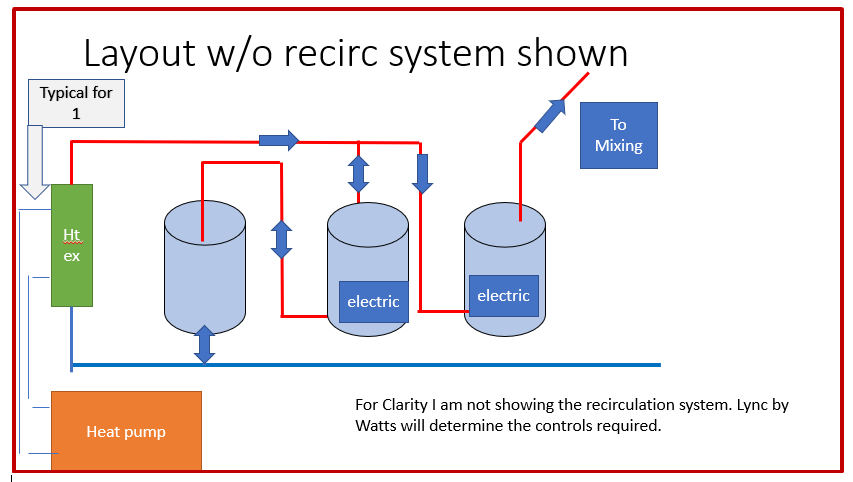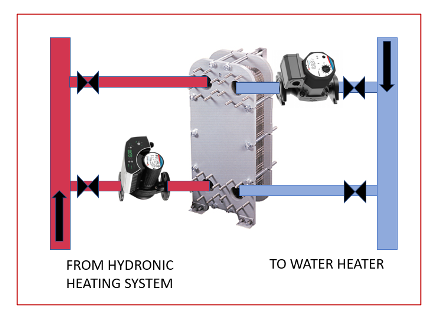The owner of a local engineering firm recently said to me, “First cost and space are key discussion points in any building design.” First cost and operating cost will be higher than gas when looking at heat pump or electric water heaters. For that reason, it can be difficult to make the case to use them regularly. In part 10 of this series, we looked at the first cost and payback of a commercial R-744 refrigerant heat pump water heater solution. Today we offer some thoughts on a hybrid solution that will drastically reduce the first cost.
The Hybrid Heat Pump Water Heater Thought
If you’re ready to use heat pump technology but can’t get buy in due to the higher first cost, let’s explore a few hybrid solutions that may drop the payback down by a couple of years. The key here is to drop the number of heat pumps required. This reduces the labor cost, the equipment first cost, and the space needed. As the engineer mentioned to me, these are all important in building design. Let’s look at how this can be accomplished.
The heat pump water heater solution will require a backup source when the temperatures drop in the winter in Michigan and Ohio. Why not use that source for the two extreme conditions: the coldest winter days and the largest ½ to 1 hour of load? What would that look like?
The Example Apartment Building
A quick review of the example system I am using. In Ann Arbor Michigan, the architect and engineer are asked to design a 4-story apartment building with a total of one hundred units expecting to serve 215 people. Each apartment has a kitchen with dishwasher, a single bathroom with a private low flow shower. Each apartment also has a washing machine. There is a handful of other hot water fixtures. We expect each floor to have four hot water supply lines and the recirculation rate from each loop will be about 0.75 GPM.
The equipment required is summarized here:
| Gas fired solution: | (3) 130-gallon tank heaters with 700,000 BTUH input each. |
| Electric solution: | (3) 119-gallon tank heaters with 216 kW input each |
| Heat pump solution: | (2) Roof mounted 239 – 549 MBH heat pump water heaters with Mechanical room mounted (4) 250-gallon tanks with backup heaters and (2) heat exchanger packages |
Just a quick look at the number of pieces of equipment needed will lead you to the first cost gap.
In part 10 of the series, Example Apartment Building Costs, I provided a chart showing a first cost comparison and the payback of equipment only with no labor. There is a payback, and the goal is decarbonization, not first cost savings. If there is a 5% inflation or penalty for the limited future electrical usage, the payback would be 12 years.
Hybrid System One: Combination Use of Heat pump and Backup System
The heat pump water heater is piped like the complete heat pump system. The electric elements may be replaced by other sources such as steam or hydronic system hot water coils. The capacities of the elements and storage may change depending on the load.
The idea is simple. The heat pump operates year-round to provide the domestic hot water, which is stored in the tanks at, for example, 160°F. If the heat pump cannot keep up, the secondary source engages to heat the water. The amount of storage and electric element capacities may be adjusted together for the best solution.
By using this hybrid model, I found that in the example system, the electric elements would be used for part of the load for one hour in the summer and only five hours per day when it was zero degrees outside. The operating cost went up a small amount, but the initial cost dropped considerably. The payback would drop as follows.
| Hybrid System Example Payback (no labor included) | |
|---|---|
| Electrical Utility Penalty/ Inflation Multiplier | Simple Payback in Years |
| 0% | 6 |
| 4% | 5 |
| 5% | 4.7 |
| 6% | 4.5 |
| 7% | 4.3 |
| 8% | 4.1 |
Lync and R. L. Deppmann will collaborate with you in Michigan and Ohio to determine the proper controls for the best hybrid solution. This may not work in all buildings but is a great option to review when space and first cost requirements of multiple heat pump water heaters may seem prohibitive.
Hybrid System Two: Using Hydronic Heating to Preheat
I really like the combination of hydronic heating and an air source heat pump water heater. The R-744 heat pump will have about 50% less capacity in the winter then in the warmer summer months. The hydronic system reset temperature will be hotter in the winter than in the summer. The domestic water load would not change much with the weather. This clearly can combine to provide a win.
Use a heat exchanger and pump with a primary secondary piping arrangement. This would be similar to the preheat system described in my Hot Water Heater Decarbonization: Using Condenser Water to Pre-Heat the Incoming Cold-Water (deppmann.com), the difference being the control. The pump would be controlled by a temperature sensor in the heat pump tank system. The water would only be preheated to about 60°F.
In my example, this would reduce the load enough to use a single Lync by Watts, Aegis A-500 R-744 heat pump water heater.
You may wonder, why not just use a heat exchanger package, such as the Aerco Smartplate, for the entire winter load? We invested in the Aegis-A heat pump and the COP will remain above one. Assuming the hydronic boilers are electric with a COP of one, why not gain the economic advantage of the heat pump all year round.
Match the Client Needs with the Right Solution from R. L. Deppmann Company
You are the engineer and a leader in introducing the newest technologies. If your client in Michigan or Ohio wants to explore decarbonization, give us a call and we can help you with the choices that save the planet and save your client’s operating cost while being mindful of first cost. You can provide your client the best of both worlds by choice rather than waiting until you’re required to do so by mandates from the authorities.
Part 1: Heat Pump Water Heaters: The Road to Decarbonization
Part 2: Heat Pump Water Heaters: How They Work
Part 3: Heat Pump Water Heaters: Refrigerants and Weather
Part 4: Heat Pump Water Heaters: Temperatures & Storage
Part 5: Heat Pump Water Heaters: Parts & Pieces & Storage
Part 6: Heat Pump Water Heaters: Hot Water Recirculation
Part 7: Heat Pump Water Heaters: Standby Capacity
Part 8: Heat Pump Water Heaters: Capacity, COP, and Weather
Part 9: Heat Pump Water Heaters: Example Apartment Building
Part 10: Heat Pump Water Heaters: Example Apartment Building Costs (Part 10)



